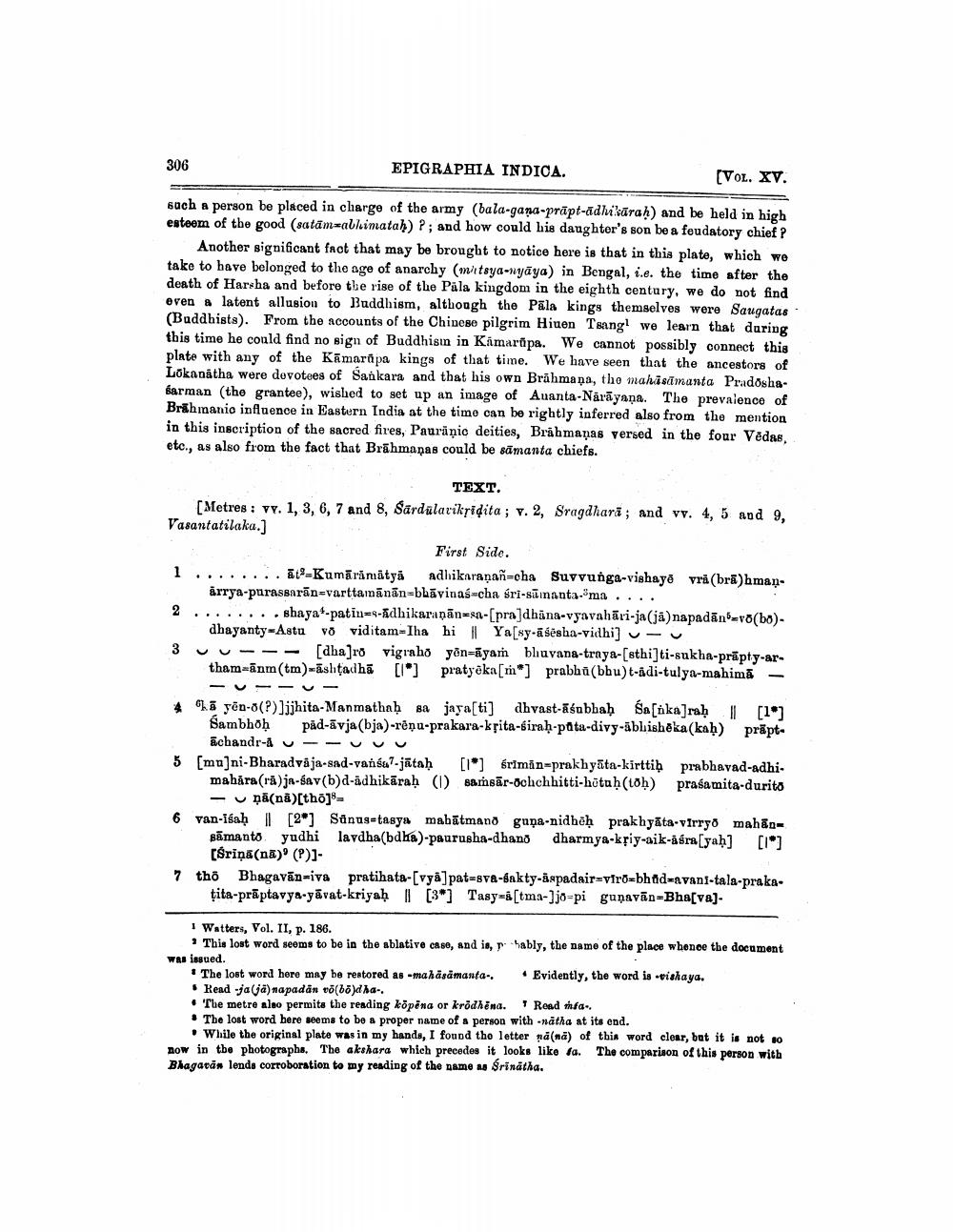________________
306
EPIGRAPHIA INDICA.
(VOL. XV.
such a person be placed in charge of the army (bala-gana-prāpt-adlukūrah) and be held in high esteem of the good (satamwabhimatah) ? ; and how could his daughter's son be a feudatory chief?
Another significant fact that may be brought to notice here is that in this plate, which we take to have belonged to the age of anarchy (mitsya-wyāya) in Bengal, i.e. the time after the death of Harsha and before the rise of the Pala kingdom in the eighth century, we do not find even a latent allusion to Buddhism, although the Pāla kings themselves were Saugatas(Buddhists). From the accounts of the Chinese pilgrim Hiuen Tsang! we learn that during this time he could find no sign of Buddhisın in Kimarapa. We cannot possibly connect this plate with any of the Kāmaräpa kings of that time. We have seen that the ancestors of Lokanatha were devotees of Sankara and that his own Brāhmaṇa, the mahasāmanta Pradoshasarman (the grantee), wished to set up an image of Auanta-Nārāyana. The prevalence of Brāhmanio influence in Eastern India at the time can be rightly inferred also from the mention in this inscription of the sacred fires, Pauri nic deities, Brāhmaṇas versed in the four Vedas, etc., as also from the fact that Brāhmaṇas could be samanta chiefs.
TEXT. [Metres : vy. 1, 3, 6, 7 and 8, Sārdalarikridita ; v. 2, Sragdharā; and vv. 4, 5 and 9, Vasantatilaka.]
First Side. 1........ āt?-Kumāramatya adhikaraṇañ-cha Suvvunga-vishayé vri(brā)hman.
ärrya-purasbrān=varttamānān=blāvinaś=cha sri-sīmanta-ma .... 2........ shaya-patin--Adhikarunānusa-(prajdhana-vyavahāri-ja(ja) napadān=v0(bo)
dhayanty-Astu vo viditam-Iha hi|| Ya[sy-āsésha-vidhi] v U 3 v u - - - [dha]ro vigraho yén=āyam bhuvana-traya-[sthi]ti-sukha-prāpty-ar
tham-anm(tm)-ashtadhā [1] pratyèka[] prabha (bbu) t-adi-tulya-mahimā -
- - - - 4 17 yen-8(?) Jijhita-Manmathaḥ sa jayasti] dhvast-asubhaḥ Sa [ika]rah [10]
Sambhoh pad-āvja(bja)-rēņa-prakara-ksita-sirah-pata-divy-ablisheka (kah) präpt
āchandr-i v--uvu 5 [majni-Bharadvaja-sad-vanśt-jātaḥ [1] frimin=prakhyāta-kirttiḥ prabhavad-adhi
mahára (ra)jn-sav(b)d-adhikāraḥ (1) samsār-ochchhitti-hütuḥ(10h) prasamita-durito
- unā(na)[thoje6 van-isah || [2] Sänugetasya mabātmand guņa-nidhiḥ prakhyāta-virry mahão
sāmanto yudhi lavdha(bdha)-paurusha-dhand dharmya-kriy-aik-aśra(yah] [1]
[Šriņi(na)' (R)]7 tho Bhagavān-iva pratihata-[vyä]pat=sva-lakty-ispadair=viroxbhd=avani-tala-praka
ţita-prāptavya-yāvat-kriyah | [3] Tasy=x[tma-]jo-pi gunavīn-Bhasva).
1 Watters, Vol. II, p. 186.
This lost word seems to be in the ablative ans, and is, hably, the name of the place whence the document Was issued
• The lost word here may be restored as -mahasamanta. Evidently, the word is vishaya. . Read .ja (ja) napadán võ(bő)dha. • The metre also permits the reading köpena or krödhëna. " Read tha.. • The lost word bere seems to be a proper name of a person with natha at its end.
. While the original plate was in my hands, I found the letter na(na) of this word clear, but it is not so now in the photographs. The akshara which precedes it looks like fa. The comparison of this person with Bhagavan lenda corroboration to my reading of the name as Srinatha.




